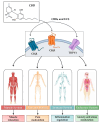Treatment Strategies for Painful Pelvic Floor Conditions: A Focus on the Potential Benefits of Cannabidiol
- PMID: 39766334
- PMCID: PMC11727302
- DOI: 10.3390/biom14121627
Treatment Strategies for Painful Pelvic Floor Conditions: A Focus on the Potential Benefits of Cannabidiol
Abstract
Painful conditions of the pelvic floor include a set of disorders of the pelvic region, discreetly prevalent in the female population, in which pain emerges as the predominant symptom. Such disorders have a significant impact on quality of life as they impair couple relationships and promote states of anxiety and irascibility in affected individuals. Although numerous treatment approaches have been proposed for the management of such disorders, there is a need to identify strategies to promote muscle relaxation, counter pelvic pain, and reduce inflammation. The endocannabinoid system (ECS) represents a complex system spread throughout the body and is involved in the regulation of numerous physiological processes representing a potential therapeutic target for mood and anxiety disorders as well as pain management. Cannabidiol (CBD), acting on the ECS, can promote relief from hyperalgesia and allodynia typical of disorders affecting the pelvic floor and promote muscle relaxation by restoring balance to this delicate anatomical region. However, its use is currently limited due to a lack of evidence supporting its efficacy and harmlessness, and the mechanism of action on the ECS remains partially unexplored to this day. This comprehensive review of the literature examines the impact of pain disorders affecting the pelvic floor and major treatment approaches and brings together the main evidence supporting CBD in the management of such disorders.
Keywords: cannabidiol; cannabinoid receptors; endocannabinoid system; pelvic floor conditions; pelvic pain; physiology.
Conflict of interest statement
The authors declare no conflicts of interest. The company Eusphera Nutraceutical had no role in the design of the study; in the collection, analyses, or interpretation of data; in the writing of the manuscript; and in the decision to publish the results.
Figures

Similar articles
-
Transvaginal Trigger Point Injections Improve Pain Scores in Women with Pelvic Floor Hypertonicity and Pelvic Pain Conditions.Female Pelvic Med Reconstr Surg. 2019 Sep/Oct;25(5):392-396. doi: 10.1097/SPV.0000000000000581. Female Pelvic Med Reconstr Surg. 2019. PMID: 29621041
-
A Systematic Review of Intravaginal Diazepam for the Treatment of Pelvic Floor Hypertonic Disorder.J Clin Pharmacol. 2020 Dec;60 Suppl 2:S110-S120. doi: 10.1002/jcph.1775. J Clin Pharmacol. 2020. PMID: 33274514
-
Motor cortical neuromodulation of pelvic floor muscle tone: Potential implications for the treatment of urologic conditions.Neurourol Urodyn. 2019 Aug;38(6):1517-1523. doi: 10.1002/nau.24014. Epub 2019 May 1. Neurourol Urodyn. 2019. PMID: 31044482 Free PMC article.
-
Vaginal Diazepam for Nonrelaxing Pelvic Floor Dysfunction: The Pharmacokinetic Profile.J Sex Med. 2019 Jun;16(6):763-766. doi: 10.1016/j.jsxm.2019.03.003. Epub 2019 Apr 19. J Sex Med. 2019. PMID: 31010782
-
The Role of Physical Therapy in Sexual Health in Men and Women: Evaluation and Treatment.Sex Med Rev. 2019 Jan;7(1):46-56. doi: 10.1016/j.sxmr.2018.09.003. Epub 2018 Nov 28. Sex Med Rev. 2019. PMID: 30503726
References
Publication types
MeSH terms
Substances
LinkOut - more resources
Full Text Sources
Medical

